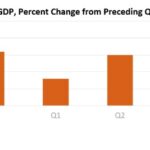By: Katie Parente, Director, Bennington Partners/Sheshunoff Consulting + Solutions
Effective June 16, 2022, the Federal Reserve raised the interest rate paid on reserve balances to 1.65% and Prime Rate has subsequently increased to 4.75%. Inflation remains elevated and according to U.S. Labor Department data published on June 10th, the annual inflation rate was 8.6% for the 12 months ended May 2022, the largest annual increase since December 1981.
A rising rate environment can expose an institution to reduced net interest income, reductions from other rate-sensitive income sources as well as increased credit risk for loans, and result in some or all of the following:
- Existing variable rate loans and repricings of other loans will lead to an increased risk of default and lower risk ratings. For example, a $1,000,000 25-year loan currently priced at 3.5% and with Net Operating Income of $73,000 currently have Debt Service Coverage of 1.22x. If it reprices just 2.0% higher at 5.5%, DSC would now be below 1.00x, at 0.99x.
- Banks that rely heavily on short-term and more rate-sensitive funding sources may experience a material increase in funding costs as interest rates rise. Many banks may not be able to offset such higher funding costs through increased asset yields.
- Mortgage prepayments typically decline in a rising rate environment, extending the duration of lower-coupon, fixed-rate mortgages and locking banks into lower-yielding assets for longer periods. Like mortgage loans, longer-term, fixed-rate mortgage-backed securities are also exposed to extension risk.
- Liability-sensitive banks have longer term asset maturity and repricing structures compared those with a shorter-term liability structure. In a rising rate environment, the NIM of a liability sensitive institution will worsen as the cost of the bank’s funds increases more rapidly than the yield on its assets.
- In an inflationary environment, one benefit for loans with low fixed rates is that it is often easier for borrowers to make payments. Conversely, as customers take out new loans at higher rates, their risk of default potentially increases, especially during a recession.
- The volume of customer deposits has increased substantially in the last several years. Banks have paid little or no interest on those deposits, but they will likely have to adjust the rates upward at some point. If deposit rates not rise as fast as loan rates, customers with large deposit balances are likely to withdraw large sums from deposit accounts and pay down floating-rate loans, increasing loan prepayments and exacerbating the need to generate new business.
The Critical Role of the Asset Liability Committee (ALCO)
As economic disruptions increase in severity and speed, a robust and effective ALCO becomes more important than ever.
A real time, forward-looking approach to evaluating different strategies and how their risk/reward trade-offs affect the bank’s interest rate risk profile and profitability is essential, both internally for the bank, and externally for the regulators.
- Some of the key areas to address include the earning asset mix, liquidity management, deposit pricing, wholesale funding, the investment portfolio, capital, tax minimization, and rate risk:
- Specific strategies should be discussed, formulated and well documented in the minutes. The objectives of various strategies are profit improvement and/or risk management.
- The committee should create policies that specify risk tolerance limits and how the bank plans to stay within those parameters.
- A number of variables affecting the bank’s risk profiles should be considered. The main one, obviously, is interest rates. By now, most, if not all banks are simulating rate shocks of +/- 400 basis points to see the effect on earnings. It’s also a good practice to simulate non-parallel rate shifts (e.g., the short end of the yield curve rising faster than the long end, or rates on loans increasing faster than deposit rates) to see the effect on earnings in a variety of scenarios.
- Other metrics to focus on may include loan prepayment speeds, betas/decay rates for deposit accounts (especially for NOW and MMDA products), and pricing spreads.
Regulatory Focus
In the current economic environment, financial institution examiners will put ever more focus on the strength of an institution’s interest rate risk measurement and management programs, any material weaknesses in risk management processes, or high levels of interest rate risk relative to capital or earnings. Regulators are currently being especially critical of lax or deficient Asset/Liability policies and procedures.
The adequacy and effectiveness of management’s use of interest rate risk models is being heavily scrutinized:
- Data input should be accurate, complete, and relevant.
- Assumptions must be reasonable, and must be tested and reviewed periodically.
- Significant leverage programs should be fully understood and thoroughly documented.
- Sensitivity stress tests should include a reasonable range of unexpected rate shocks. Bank management should provide for stress tests that include potential interest rate changes and meaningful stress situations using a sufficiently wide range in market interest rates, and both immediate and gradual shifts in market rates.
- The variance between the forecasted risk levels and actual risk exposures should be analyzed routinely.
Key Takeaways
- Credit risk will increase for existing variable rate loans and for all loans that reprice, effecting credit quality and reserves.
- Banks need to document their rate sensitivity discussions and ensure that their ALCO minutes document the choices they entertained and employed.
- Institutions should increase their ALCO modeling and test these effects on their current year budgets.
- Budget assumptions should be reviewed and discussed as necessary to account for macro-economic changes.
- Risk tolerance limits should be well documented and explained if they are exceeded.
Sheshunoff is available to support your institution on any interest rate or economic questions you may have.
Sources:
https://www.fdic.gov/regulations/examinations/supervisory/insights/sisum05/sisummer05-article1.pdf
www.fdic.gov – Statements of Policy – FDIC Law, Regulation, Related Acts
www.wolterskluwer.com – Managing Interest Rate Risk in a Rising Rate Environment






